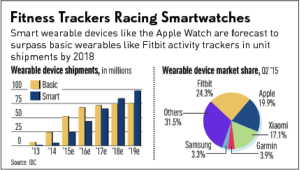The Fitbit Fad?
Fitbit owes its success to strong direct network effects, but its survival depends on the establishment of a strong indirect network.
The Direct Network
With $400 million in revenue in Q2 of 2015, Fitbit turned a $130 million profit for 2014. Fitbit can attribute much of its present success to the strong direct network effects it established early on. The technology offered consumers individual fitness data that they could upload onto a website that would display their information in the form of personalized trends and statistics. Not only could users use this information to make real lifestyle changes, they could also connect directly to friends – a feature that many found useful in fostering competition and accountability. Fitbit quickly became a platform by which users (both friends and strangers) could support, motivate, or compete with one another – all for the purpose of achieving health and fitness goals.
Competition
Competition within the wearable category has been intensifying, however. Fitbit has proven that it is able to outshine several competitors, such as Xiaomi and Jawbone, but what about the smart-watch revolution that is currently unfolding before us? Right now, Fitbit still retains the largest slice of the pie at 24.3% market share. Smart watches, such as the Apple Watch, are expected to outcompete Fitbit by 2018. This begs the question, is the Fitbit fad nearing its end?
If it continues to rely on direct network effects to propel its user base, then the answer to that question is likely “yes”. However, Fitbit is already building up its base of complements, and rumors regarding its future plans are already circulating. If Fitbit is able to successfully leverage indirect network effects, then only does it stand a chance against the Apple and Google products. One of Fibit’s major assets – in addition to its widespread user base – is its enormous repository of data. With open APIs, Fitbit is able to sync with other platforms, such as My Fitness Pal, thus providing users with an enhanced experience.
Future Survival
Such indirect effects are not enough, however. Fitbit’s survival depends on its ability to find strong partners with tailored expertise. For example, if Fitbit can partner with a data analytics giant, such as IBM Watson, the enormous pool of data (that is of little practical use currently) can be translated into useful and monetizable information. This can provide a gateway to the healthcare space; the field is waiting to jump on the wearable wave, provided that useful and practical information can be gleaned from the devices. With the ability to translate this data into something applicable and practical to healthcare providers, Fitbit can further strengthen its indirect network through relationships with insurance companies, hospital networks, and providers.
If Fitbit is slow to jump on these opportunities, it can expect to be made obsolete by the smart watch category. It currently prides itself on being focused on tasks solely related to fitness and health, whereas products like the Apple Watch offer a wide variety of functionality. But, it is not unreasonable to assume that these smart watches will be able to everything Fitbit claims to do, and to do it better. If- or perhaps when – this happens, the Fitbit fad will officially be over.




What an interesting article! I used to own a Nike Fuelband, which was perfect for me because of its seamless integration into my nike running apps on the iphone. In upgrading to a fitbit flex after fuelbands were discontinued, I found that it had both significant hardware issues (not syncing to my iphone app, low battery life) in addition to less of a network effect (I missed competing for “fuel” on the nike system). Based on my personal experience I would agree with your suggestion that Apple and its watch will be sure to put fitbit out of business over the longer term due to its integration into existing devices and its multipurpose use.
I’m a loyal fitbit user, though I’m not sure there is more than just a weak direct network effect in the platform. I bought the fitbit to replace a GPS watch for tracking my runs, and I have purchased another one because I liked the app and its partners. It was over a year before I got my first “friend” on the network, and I didn’t see the benefit there beyond a little friendly competition, which hasn’t necessarily increased the more friends I have using a fitbit. To me the technology is key – so long as they maintain their technical advantage over the terrible pedometer technology in Apple products, they will have the advantage. I do think they are vulnerable, but not to Apple Watch, instead to whoever first designs a wearable that is viewed as fashionable for females. Neither the fitbit (thought they’re now partnering with fashion designers) nor the Apple Watch are particularly fashionable, so I think whoever can make the technology a piece that people want to wear, will win significant market share and be in a position to take advantage of network effects. I agree that Apple will probably win the war, just not with their current version of the watch.
I wonder if FitBit has crossed the point at which adoption is widespread enough that historical data matters. There’s a lot of people who use it, but there are far more people who don’t use it. And if a comparable device comes out that is more readily carried and accessed, Google (as you noted) could definitely overtake it in users who don’t have any historical data. The switch might be painful for the current Fitbit users, but I wonder if the data will ever be transferable between devices (or exportable). It seems like it would be suicidal for Fitbit to offer that, but if the users demand it enough it might be a lose-lose for them.